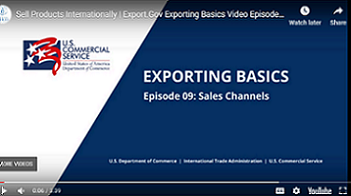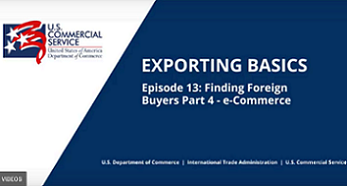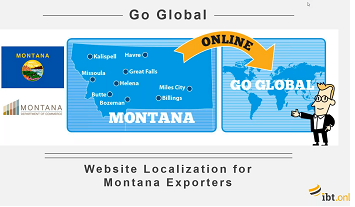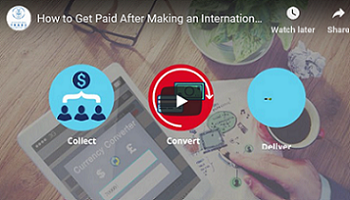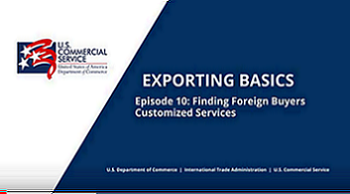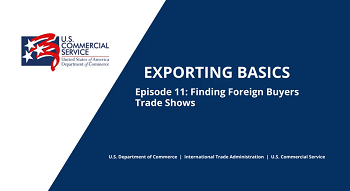Market Entry
Define Your End User
I want to read about it
- How do you need to sell to them — via personal sales, web interactions or relationships?
- Will you have lots of customers with small orders or a few customers with large or high-dollar orders?
- Will customers need a lot of support to use your product?
- Will they often need repairs and other customer support to use your product?
I want to watch a video about it
I want to talk to a person about it
Decide How To Market to Your End User
There are several ways to reach your end user. Your first consideration is your preference for how to enter the market: direct and on your own, or using a rep or distributor? Next, consider the typical market entry strategy for your product in your chosen country. For guidance, review the “Market Entry Strategy” section of the Country Commercial Guide for your chosen country.
You can also complete an international e-commerce roadmap with the New Hampshire eGlobal Institute.
Read more below to understand the path to the customer and additional considerations for each market entry strategy.
E-Commerce or Direct
In e-commerce, the customer orders via e-commerce, and you ship from your warehouse to the customer. In direct sales, the customer orders from you, and you ship from your warehouse to the customer.
- How does a customer find you?
- How are you going to service repairs or returns?
- To sell to 100 customers, you will receive 100 payments.
- You receive 100% of the payment, but how much did you pay to find the customer, coordinate the single shipment and take in the single payment?
E-commerce favors passive engagement with customers for small transactions, while direct sales favor a small number of end users and large orders.
Rep or Agent
The rep or agent finds the customer and makes the sale. You ship from your warehouse to the customer.
- They are on the ground in the market, understanding the culture and business climate.
- They find the customers for you, but you don’t have direct contact or a relationship with the customer.
- To sell to 100 customers, you will receive 100 payments.
- You only pay the rep or agent when they make a sale, but the commission take a percent off your bottom line.
This strategy favors sale of products or product lots that would make commissions worthwhile.
Distributor
You ship a large quantity of items to the distributor, who warehouses them in market. The customer orders from you or the distributor, and the distributor ships to the customer.
- If the distributor does not assist with marketing, which they often don’t, how does a customer find you?
- To sell to 100 customers, you can sell one of a lot of products to the distributor for one payment; they accept payments from 100 customers.
- You must sell the product minus a markup, taking a percent off your bottom line.
This strategy favors large numbers of end users with small order sizes.
Rep and Distributor
You ship a large quantity of items to the distributor, who warehouses them in market. The rep makes the sale, and the distributor ships to the customer.
- This is a good combination of finding and delivering to the customer.
- Both the rep and the distributor will take a percent off your bottom line.
This strategy favors sale of products or product lots that would make commissions worthwhile and large numbers of end users with small order sizes
e-Commerce
I want to read about it
Worldwide economic development and growth of the middle class has put increased purchasing power in the hands of millions of new consumers. Global cross-border e-commerce sales alone total some $2 trillion annually and are expected to exceed $6 trillion by 2020. Are you ready to take advantage of growing international selling opportunities? Find new foreign buyers and position your company by utilizing customized e-commerce and social media platforms and strategies, as numerous exporters have successfully done.
While international sales are often more easily attained through cross-border e-commerce, new opportunities bring new responsibilities: complying with regulations, collecting additional information about your product and managing new risks. Click here for a checklist that outlines the elements needed to find international buyers and complete international sales, including target markets, selling methods, intellectual property and regulations, customer service issues, etc. Integrate these items into your business operations from the start of the sales-and-fulfillment process.
Visit the U.S. Commercial Service’s E-commerce Innovation Lab for additional reading and resources on this topic.
I want to watch a video about it
Finding foreign buyers
International website optimization — specific for Montana exporters
How to get paid
I want to get grant funds to help
The Export Montana Team's Montana Online Global Program provides 50% reimbursement of the cost of international website optimization.
I want to talk to a person about it
Licensing
I want to read about it
Technology licensing is a contractual arrangement in which the licenser’s patents, trademarks, service marks, copyrights, trade secrets or other intellectual property may be sold or made available to a licensee; compensation is negotiated in advance between the parties. Payment may be in the form of a lump-sum royalty, a running royalty based on volume of production, or a combination of both. U.S. companies frequently license their technology to foreign companies who manufacture and sell products in one or more countries, per the licensing agreement.
A technology licensing agreement usually enables your company to enter a foreign market quickly, and it poses fewer financial and legal risks than owning and operating a foreign manufacturing facility or participating in an overseas joint venture. Licensing also permits U.S. companies to overcome many tariff and non-tariff barriers that frequently hamper the export of U.S.-manufactured products. Therefore, licensing can be attractive for small companies or companies with little international trade experience. Technology licensing may also be used to acquire foreign technology through cross-licensing agreements or grant-back clauses that award rights to improved technology developed by a licensee. Seek legal advice to determine liability.
As a form of exporting, technology licensing has some drawbacks. Your control over the technology is weakened because it has been transferred to another company; additionally, licensing usually produces smaller profits for your company than exporting actual goods or services. And in some countries, adequately protecting the licensed technology from unauthorized use by third parties may be difficult.
You should register your patents and trademarks in each country. Copyright is recognized globally, but patents and trademarks are territorial, so rights may vary depending on different countries’ legal conventions. You only need to file your patents and trademarks once with the European Union, as EU laws apply to all EU members. The Patent Cooperative Treaty and the Madrid Protocol allow you to apply for patent protection in the EU, as well as in specific countries throughout the world.
When considering technology licensing, remember that foreign licensees may attempt to use the licensed technology to manufacture products that compete with your company or other licensees. Often, U.S. licensers may try to impose territorial restrictions on foreign licensees, depending on U.S. and foreign antitrust laws and host country licensing laws. Also, U.S. and foreign patent, trademark and copyright laws can often be used to bar unauthorized sales by foreign licensees, provided the U.S. licenser has valid protection in the applicable countries.
Many countries, particularly members of the EU, also have strict antitrust laws that affect technology licensing. The EU’s block exemption regulation — Commission Regulation No. 772/2004 of April 27, 2004, dealing with the application of article 81(3) of the Treaty of Rome to categories of technology transfer agreements — governs patent and information licensing agreements, as well as design and model rights and software copyright licenses. If you are currently or considering licensing technology to the EU, be sure to understand and carefully consider the regulation.
Due to the complex nature of international technology licensing, be sure to get qualified legal advice in the United States before entering into an agreement. It’s also often a good idea for U.S. licensers to retain qualified legal counsel in the host country for advice on applicable local laws and assistance in securing the foreign government’s approval of the agreement. Sound legal advice and thorough investigation of the prospective licensee and the relevant practices of the host country will increase the likelihood that your licensing agreement will be a profitable transaction.
I want to watch a video about it
Intellectual Property: Licensing
I want to talk to a person about it
Sales Representatives and/or Distributors
I want to read about it
An overseas sales representative is the equivalent of a manufacturer’s representative in the United States. The representative uses your company’s product literature and samples to present the product to potential buyers. Ordinarily, a representative handles many complementary lines that do not conflict. The sales representative usually works for a commission, assumes no risk or responsibility and is under contract for a definite period of time which is renewable by mutual agreement. The contract defines territory, terms of sale, method of compensation, reasons and procedures for terminating the agreement and other details. The sales representative may operate on either an exclusive or a nonexclusive basis.
The foreign distributor is a merchant who purchases goods from a U.S. exporter, often at a discount, and resells them for a profit. The foreign distributor generally provides support and service for the product, relieving the U.S. exporter of those responsibilities. The distributor usually carries an inventory of products, a sufficient supply of spare parts and adequate facilities and personnel for normal servicing operations. Distributors typically handle a range of noncompeting, complementary products. End users do not usually buy from a distributor; they buy from retailers or dealers.
Considerations for Selling via Sales Reps or Distributors
|
Consideration |
Reps and Agents |
Distributors |
Generally Favors |
|
Type of representation |
Exclusive or non-exclusive |
Exclusive or non-exclusive |
Neutral |
|
Size of company |
Often a one-person company |
Can also be a small operation but is generally larger than agents |
Distributor, depending on industry |
|
Takes title to the goods during the sale and overseas inventory maintained? |
Typically, no |
Yes |
Distributors, because exporter deals with only one company and one invoice |
|
How does the rep earn its profit, and does the exporter have strong control over foreign pricing? |
Generally high control over pricing through commissions paid to agent directly by exporter |
Generally low control over pricing on the margin between their purchase price from the exporter and the selling price to pricing the local end users or next level of distribution |
Agents, because the exporter has more control over foreign pricing |
|
Marketing activities such as advertising, trade shows and translations of marketing materials |
Low compared to distributors |
High compared to agents |
Distributors, assuming such activities are not done by the exporter |
|
Customer support activities such as training, warranty repair and customer inquiries |
Low compared to distributors |
High compared to agents |
Distributors, assuming such activities are not done by the exporter |
|
Foreign receivable risk, assuming terms do not include payment in advance |
Potentially high, because each sale can be to a different buyer |
Potentially lower, because sales are to the same distributor |
Distributors |
|
Speed of delivery of goods to foreign end user |
Slower compared to distributors, if no inventory is maintained |
Faster compared to agents, if inventory is maintained |
Distributors, assuming maintaining foreign inventory is of benefit |
|
Knowledge of importing procedures and local regulations |
Perhaps lower than distributor, but varies greatly |
Generally strong |
Distributors |
|
Termination of relationship challenges |
In some countries, agents can be legally treated as employees, making termination complicated. |
In some countries, local laws strongly favor distributors, making termination complicated. |
Varies by country |
|
Preference of local market |
Some markets tend to use agents more than distributors. |
Some markets tend to use distributors more than agents. |
Varies by country |
I want to talk to a person about it
Foreign Retailers
You may also sell directly to foreign retailers, although in such transactions, products are generally limited to consumer lines. The growth of major retail chains in markets such as Canada and Japan have created new opportunities for this type of direct sale. The approach relies mainly on traveling sales representatives who directly contact foreign retailers, although results might also be achieved by mailing catalogs, brochures or other literature.
The direct mail approach has the benefits of eliminating commissions, reducing travel expenses and reaching a broader audience. For optimal results, a company that uses direct mail to reach foreign retailers should support it with other marketing activities. For more information, contact the Association of National Advertisers, formerly the Direct Marketing Association, or the U.S. Postal Service at usps.com.
U.S. manufacturers with ties to major domestic retailers may also be able to use them to sell abroad. Many large U.S. retailers maintain overseas buying offices and use those offices to sell abroad when practical.
What is the most common and consistent channel for producing the desired result among smaller U.S. exporters? The answer is distributors.
Direct Sales to End Users
You may sell your products or services directly to end users in foreign countries. The buyers may be foreign government institutions, businesses or final consumers via online sales. The buyers can be identified at trade shows, through international publications or by the overseas posts of the U.S. Commercial Service; they may find you via search engine results that you may or may not influence through search engine positioning strategies, purchases of online ads, keyword auctions and the like.
You should be aware that if a product is sold in such a direct fashion, your company is responsible for shipping, payment collection and product servicing unless other arrangements are made. If the cost of providing these services is not built into the export price, you could have a smaller profit than you had anticipated.
Find and Evaluate Foreign Buyers
Once you have decided your market entry strategy, whether it be licensing, reps, distributors or retailers, you need to develop a plan for how to find your foreign partners or buyers.
Featured U.S. Exporter Directory
Are you looking to enhance your international marketing efforts through improved search engine optimization? Advertise in FUSE, the featured directory of U.S. products on U.S. Commercial Service websites around the world.
Click here for more information about FUSE.
Click here for information on the Montana STEP Grant Program that can reimburse 50% of the cost of FUSE.
To get started on this process:
Foreign Partner Search Plan Worksheet
Use our Foreign Partner Search Plan Worksheet to prepare your plan to find a foreign partner.
International Partner Search
Are you looking for potential agents, distributors or other strategic partners overseas? The U.S. Commercial Service can save you valuable time and money by identifying prospects that match your needs without having to travel to the market.
Click here for more IPS information.
Click here for information on the Montana STEP Grant Program that can reimburse 50% of the cost of the IPS.
To get started on this process:
Once you have gotten to know potential foreign representatives, it’s a good idea and expected in some cultures for you to visit the country to meet potential business partners and observe the size, condition and location of their offices and warehouses.
Gold Key Service
Spend your time doing what you do best: managing your company. Let us identify, vet and arrange meetings with interested partners when traveling to an overseas market.
Click here for more GKS information.
Click here for information on the Montana STEP Grant Program that can reimburse 50% of the cost of the GKS.
To get started on this process:
Trade Shows
Attending or exhibiting at trade shows can be an effective way to meet prospective new international partners and to find export buyers.
Domestic trade shows
Many international buyers attend export trade shows right here in America. If a company is interested in learning more about domestic trade shows, they can contact us for additional information.
International trade shows
Click here for information on the Montana STEP Grant Program that can reimburse 50% of the cost of exhibiting at international trade shows.
Montana Pavilions
Contact us for information on available trade shows.
Trade show training
Evaluate Potential Foreign Partners
International Company Profile: Do you need a background check on a foreign company? The U.S. Commercial Service will provide in-depth or basic background check information on a specific foreign company to help determine its suitability as a potential business partner.
Click here for more ICP information.
Click here for information on the Montana STEP Grant Program that can reimburse 50% of the cost of the ICP.
To get started on this process:
Use our Foreign Partner Evaluation Worksheet to assess a foreign partner’s fit with your needs.
I need to watch a video about it
Finding Foreign Buyers: Customized Services
Finding Foreign Buyers: Trade Shows
I want to get grant funds to help
The Montana STEP Grant Program provides 50% reimbursement of the cost of:
- Exhibiting at international trade shows
- U.S Commercial Service's programs
I want to talk to a person about it
Montana Department of Commerce
301 S Park Ave, Helena, MT 59620
Contact Us | 406-841-2700
Montana Relay 711
If you experience difficulty accessing resources or content on this site, please contact us using the phone number or address above.
